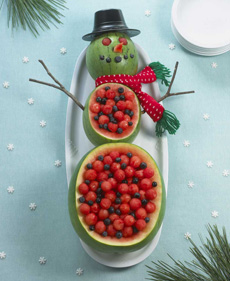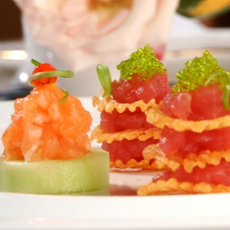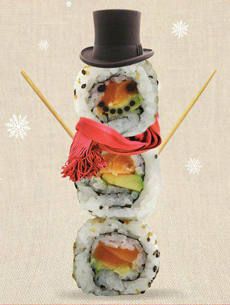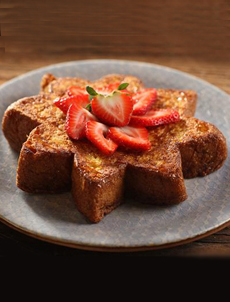
A lager on tap. Photo courtesy Samuel
Adams Brewery. |
|
December 10th is National Lager Day (see all the food holidays).
Enjoy a cold one as you read through these lager facts, compiled by the brewers at Samuel Adams.
1. History. Alhough beer has been made for more than seven millennia, the first lager wasn’t brewed until the 16th century. America’s first lager was brewed in 1838, when Bavarian brewmaster John Wagner brought lager yeast across the pond from Europe.
2. Science. Lager yeast, as opposed to ale yeast, ferments (eats sugar to produce carbonation and alcohol) at cooler temperatures. When the fermentation is finished, lager yeast settles to the bottom of the fermentation tank while ale yeast remains on top. Lager yeast also takes a longer time to condition the beer than ale yeast.
|
|
3. Character. Due in part to their clean, crisp character, lagers are labeled by some as plain or boring. That might be so with some mass-marketed beers, but craft lagers are flavorful and complex. There are also different styles of lager: Baltic Porter; Bock, Double Bock and Wheat Bock; Oktoberfest; Rauchbier and Vienna Lager, among many others, as you’ll see below.
4. Cold. Before modern refrigeration, brewers needed a way to keep their lagers cool during the brewing process. Before the advent of modern cooling tanks, German lager brewers often cooled their beer in Alpine caves or in cellars dug deeply into hillsides (the latter technique used by immigrants German-American beer makers).
5. Meaning. In German, Czech and Polish, to lager means to store, keep, preserve or keep safe.
|
|
THE DIFFERENT TYPES OF LAGER
Amber Lager, loosely based on Vienna lager (see below), can range from amber to copper in hue. It is generally more fully flavored than a standard pale lager, with caramel malt flavors. While hop levels vary considerably among breweries, amber logers tend to be hoppier than Vienna lagers. Samuel Adams Boston Lager is an amber lager.
Baltic Porter is a very high alcohol, sweet, robust porter that originated in the Baltic states. It melds both the character of original British Porters and the sweeter, highly alcoholic Russian Imperial Stouts.
Bock Beer is a strong lager first brewed in the 14th century in the German town of Einbeck. The style was adopted by Munich brewers in the 17th century using the new lager style of brewing. Due to their Bavarian accent, citizens of Munich pronounced “Einbeck” as “ein Bock” (a billy goat). The style became known as bock and, as a visual pun, the bottle labels often feature a goat.
|
|

Bock beer—dark but still a lager. Photo courtesy WisDairy.com.
|
Traditional bock is a sweet and lightly hopped with low carbonation. The color can range from light copper to brown. The taste is rich and toasty, sometimes with a bit of caramel. Several substyles of bock beer exist, including maibock or helles bock, a paler, more hopped version generally made for consumption at spring festivals; doppelbock, a stronger and maltier version; and eisbock, a much stronger version made by partially freezing the beer and removing the water ice that forms.
Doppelbock or Double Bock Beer is a dark, malty brew, rich in body and high in alcohol. It was first brewed in the Italian Alps around 1650 by the monks in the monastery of St. Francis of Paula, for sustenance throughout the Lenten season. A fun note: The monks felt that such a delicious brew might be too much of an indulgence for Lent, so they sent a cask to be judged by the Holy Father in Rome. Tossed and turned during transport across the Alps and then heated under the Italian sun, the beer turned sour. When the Holy Father tasted it, he found it vile and declared it was probably beneficial for the souls of the Munich monks to make and drink as much of it as they could.
Märzen or Oktoberfest Beer gets its name from the last month in which the beer was traditionally brewed, March (März in German). Before refrigeration, March was the last month in which beers could be “lagered,” or put into cold storage. The beers would age over the summer, to be enjoyed during the fall harvest, Oktoberfest. Märzen lagers have a deep, amber color and a malt-heavy flavor.
Rauchbier (Smoked Beer). Rauchbier is made using malted barley dried over an open flame, which imparts smoky flavors. They can range from a light smokiness to an intense—and some say acrid—level.
Vienna Lager, a cousin of Märzen, is a crisp and refreshing style characterized by its medium body, malty taste and amber color. Vienna lager is actually more popular in Mexico than in Austria. It was brought there in 1864 by Archduke Ferdinand Maximilian Joseph of Austria, who was installed by the French as Emperor Maximilian I of Mexico. He was overthrown and executed by republican forces in 1867; but the Mexicans did like his beer, and continued to make the style. Dos Equis and Modelo Especial are examples.
Winter Lager. A dark bock beer, winter lager is a style rich in maltiness for a hearty, full body, and low in bitterness. Holiday spices (ginger and cinnamon) can be added.
CHECK OUT THE DIFFERENT BEER TYPES IN OUR BEER GLOSSARY.
It’s also helpful if you don‘t know a bitter from a hop.
—Steven Gans
|
|







